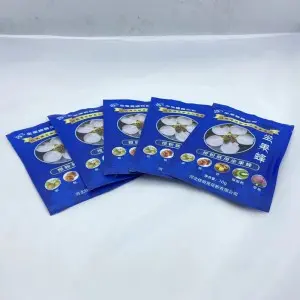Oct . 12, 2025 12:20 Back to list
Pollen Peach Tree – High-Germination Peach Pollen
PEACH FLOWER POWDER SUITABLE FOR PEACH POLLINATION: field notes, specs, and real-world outcomes
If you’ve ever wondered whether hand-applied pollination still matters in modern orchards, you’re not alone. Growers ask me every season about the pollen peach tree approach—does it move the needle, or is it just expensive dust? Short answer: used correctly, it can be a difference-maker, especially when weather, bee activity, or varietal biology get in the way.

What it is and where it comes from
This product is a curated peach blossom pollen blend processed for manual or electrostatic application in orchards. It’s produced in the Caozhuang Development Zone, Fanzhuang Town, Zhao County, Shijiazhuang, Hebei Province—a region many buyers already recognize for large-scale pollination materials. Actually, I visited a similar facility nearby a few years ago; the cold-chain discipline stuck with me—no shortcuts if you want viable grains.
Why growers use it (and when)
- Low bee flight: cold, rain, high winds during bloom.
- Self-fertile varieties still benefit: cross-pollination can bump set and uniformity.
- Greenhouses/high tunnels and heavy spray schedules limiting pollinator time.
- Targeted cross-sets to tune fruit size and shape on premium blocks.
Field data and case study
From controlled orchard comparisons reported by the manufacturer: natural pollination (Orchard A) achieved ≈60% high-grade commercial fruit, while artificial cross-pollination (Orchard B) reached ≈75%. Yield in the assisted block was about 30% higher. I’ve heard similar numbers from clients—maybe not every year, but often enough to take notice.
Product specifications (typical)
| Product | PEACH FLOWER POWDER SUITABLE FOR PEACH POLLINATION |
| Origin | Zhao County, Shijiazhuang, Hebei Province |
| Pollen viability (lab) | ≈70–90% via in vitro germination (real-world use may vary) |
| Moisture | ≤6–8% after low-temp dehydration |
| Storage & service life | -18°C: 18–24 months; 0–4°C: 2–3 weeks; ambient: 3–5 days (sealed) |
| Suggested rate | ≈0.5–1.0 kg/ha per bloom window or 2–5 g/tree; reapply after rain |
| Certifications | ISO 9001 (typical for facilities); phytosanitary docs where required |
Process flow, materials, and testing
- Materials: selected peach blossoms from compatible varieties; screened for pests/debris.
- Methods: low-temp dehydration, mechanical separation, fine sieving, UV or dry sterilization, cold-chain blending, nitrogen-flush packaging.
- Testing: pollen germination on Brewbaker–Kwack medium; FDA/fluorescein diacetate and acetocarmine staining for viability; microbial counts; moisture check; random lot cold-wake tests.
- Standards & labs: procedures aligned to FAO/academic guidance; testing by ISO/IEC 17025–accredited labs where available.
How to apply (quick guide)
- Target timing: full bloom, mid-morning (≈9–11 a.m.) when stigmas are receptive.
- Tools: electrostatic duster, air-assisted sprayer with pollen cup, or soft brush for small blocks.
- Technique: light, even pass; avoid wet petals. Repeat after rain or heavy dew events.
- Compatibility: pair with known cross-compatible cultivars; avoid oil sprays right around application.
Vendor comparison (summary)
| Vendor | JML Pollen (Hebei) | Generic Import | DIY Local |
| Traceability | Lot-level, origin stated | Varies | Depends on grower |
| Viability consistency | High, cold-chain maintained | Mixed | Highly variable |
| Testing docs | Available on request | Sometimes | Rare |
What growers say
“We use pollen peach tree treatments mostly on blocks where bees underperform—cool, drizzly bloom. Fruit counts jumped enough to justify the cost.” Another manager told me their premium grade share improved “noticeably,” which tracks with the 60% vs 75% figures above.
Bottom line
For orchards chasing uniform size and reliable set, pollen peach tree products are a smart hedge. Not magic, but when weather turns or you need precision cross-sets, the ROI can be very real.
References
- FAO. Pollination of Cultivated Plants: A Compendium for Practitioners (2018). https://www.fao.org/3/i9527en/i9527en.pdf
- University of California ANR. Home Orchard—Pollination Requirements (accessed 2025). https://homeorchard.ucanr.edu/The_Big_Picture/Pollination_Requirements/
- Brewbaker, J.L., & Kwack, B.H. (1963). The essential role of calcium in pollen germination and tube growth. American Journal of Botany, 50(9), 859–865.
-
Comprehensive Guide to CE Certification Apricot Pollen Health Benefits
NewsNov.24,2025
-
CE Certification Mango Fruit Protection Bags: Enhancing Export Quality & Sustainability
NewsNov.23,2025
-
CE Certification Varieties Suitable for Collecting Apple Pollen – Ensuring Quality & Compliance in Apple Breeding
NewsNov.22,2025
-
Comprehensive Guide to CE Certification Mango Cover Bags – Quality, Standards & Trends
NewsNov.22,2025
-
What You Need to Know About CE Certification Peach Blossom Powder Keto
NewsNov.21,2025
-
CE Certification Pear Pollen Collection Base – Ensuring Quality & Sustainability in Global Horticulture
NewsNov.20,2025